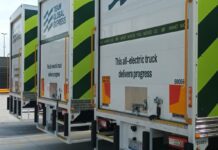
Media Release by HATCH
A leading expert says battery storage can solve inefficiencies in the transfer of electricity from renewable sources to avoid ‘wasted’ transmission capacity, and Government backing will help achieve the goal faster.
Steve Bond is Fellow of the Australian Institute of Energy, and General Manager Australasia of Power at Hatch, an award-winning multidisciplinary leader in engineering, operational and development projects in the metals, energy, and infrastructure industries. He has 30 years’ experience in consulting for, and delivering, pioneering power projects locally and internationally.
Renewable electricity capacity will improve with increased transmission lines from renewable generation centres to the cities. Still, Steve says there is an opportunity right now to better utilise the capacity of existing lines.
He says: “There is significant redundant capacity built into the present renewable electricity transmission system. This redundant capacity exists to provide reliable power supply to energy users during line outages, which reduce the available capacity to transfer power, or heatwaves, when demand for electricity surges. Because of this, the capacity available in many transmission lines is not fully utilised, and for some transmission lines the utilisation is as low as 25 per cent.”
Steve says battery storage is a viable solution. “Currently, development and making the energy storage available through batteries can be done at a reasonable cost. The gradual transition to electric vehicles will increase the amount of energy storage available in cities, including households. Some electric vehicle manufacturers are already providing the option of drawing the charge stored in the electric vehicle batteries for use elsewhere.”
Steve says the availability of storage at households, commercial and industrial premises will change how we use electricity. “As the take up of electric vehicles increases, we won’t expect electricity to be transmitted from generators to our appliances when we flick a switch. The energy will be transmitted and stored in our batteries when it is cheapest to do so, and we will use the stored electricity whenever we want it.
“This means that reserving redundant capacity in transmission lines for rare events will no longer be needed. The energy stored in the batteries can be used to ride through outages without impacting on the availability of electricity for everyday usage.”
He further added: “We should not underestimate the impact that future changes in the transport sector will have on electricity transmission. Our cars will become more than just vehicles to get us from A to B. They will be used as part of an energy storage network. An electric car will be seen as battery that comes with a car, rather than the other way around, and can connect to the grid in different places. Although it my not happen within next couple of years, the fuel cells in hydrogen-powered cars will be perceived in the same way.”
In referring to the recent aberrations seen in the national electricity market because of reduction in generation, Steve also observed: “Batteries in cars or installed in homes are also a source of generation, which can be used if and when there is a deficiency in the generation supplied from the large grid-connected generating plants.”
Steve says the battery and system technology is already available. All that is required is government backing to increase its uptake. “We need a policy framework and incentives to increase the proliferation of batteries to our households and businesses, to increase the proliferation of electric-powered vehicles, and a market framework where the electricity can be traded and stored for future use by consumers.”
Image Credit: www.hatch.com




















